The Sentinel Steam Railcars
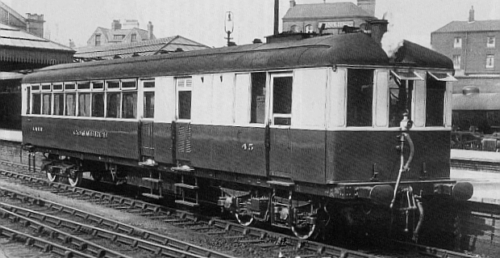
Sentinel Waggon Works of Shrewsbury built their first steam railcar in 1923 for the narrow gauge Jersey Railways & Tramways Ltd. This used coachwork constructed by Cammell Laird & Co. of Nottingham, and was reportedly successful. Another railcar was exhibited at the British Empire Exhibition in 1924, and came to the attention of Gresley. The LNER was in need of vehicles that were cheaper than steam trains but with better carrying capacity than that of the petrol rail bus and auto car on trial in the North East (NE) Area. Hence Chief General Manager Wedgwood informed the Joint Traffic and Locomotive Committees on 31st July 1924 that a railcar would be loaned from Sentinel for a fortnight. If successful, this would be followed by the purchase of two railcars. The trial took place from 17th to 31st August 1924 in the NE Area.
The trial was a success and was followed by the purchase of eighty Sentinel steam railcars from 1925 to 1932. The LNER also maintained the four Sentinel steam railcars that were operated by the Cheshire Lines, and took possession of Axholme Joint Railway (AJR) railcar No. 44 when it ceased passenger services in 1933. The AJR was jointly operated by the London Midland Scotland (LMS) Railway and the LNER.
All of the Sentinel steam railcars used bodywork constructed by Cammell Laird & Co, although Cammell Laird became a part of Metropolitan-Cammell Carriage, Wagon & Finance Co. Ltd ('Metro-Cammell') in February 1929.
Most of the railcars had a single engine with a vertical water tube boiler. The cylindrical boiler had an outer shell with an inner firebox. Coal was fed through a chute at the top, onto the grate at the bottom of the firebox. The firebox was designed to be removed, leaving the boiler in-place. Fireboxes changes were frequent, and were even known to have occurred at running sheds. Water tubes were arranged across the firebox in a spiral pattern, set in corrugations in the firebox casing. Firebox construction was considered a specialised task, and Sentinel contracted construction out to Galloways of Manchester. By 1928, Sentinel had started to switch back to their own square-section fireboxes for road vehicles and Y1 & Y3 0-4-0T shunters. The switch-over was gradual, but all fireboxes were of the square type before Galloways went out of business in 1932. These square fireboxes had a central firebox that was pressed into a square section. The spiral tube arrangement was replaced by tubes which were only inclined slightly across the firebox. Half of the tubes had screwed ends and were used as stay tubes to add strength to the firebox.
The eighty Sentinel steam railcars were produced in a long series of relatively small batches. Each batch varied with both detail and significant mechanical differences. The development of the Sentinel railcars and the differences between the different designs is described below.
The LNER instituted an all-line enquiry in the effectiveness of the company's various railcars, for the year ending 30th September 1934. The report shows that the best of the Sentinel steam railcars easily outperformed the Armstrong-Whitworth diesel-electric railcars. The entire fleet of Sentinel cars recorded over 2.25 million miles in the year, with railcar mileages often exceeding 30,000 miles.
Maintenance requirements varied widely amongst the railcar fleet. Some railcars were laid up for long periods of time with numerous repairs. In contrast others clocked up high mileages between repairs. For example, No. 2135 Integrity only required four General Overhauls and two Light Repairs in its entire twenty year life.
The boilers posed a number of maintenance problems, particularly with the water feed arrangements. The ram pump and injector worked well if they were maintained correctly. However if the glands were packed too tightly, then gear wheel wear was excessive and the pump would quickly fail. Inadequate packing of the glands would result in water accumulating in the engine crank case. Injectors also tended to fail due to scale blockages. A trial with a Weir pump did occur, and appears to have been a success. This scheme only kept the existing injectors as a back-up. Although the boiler feed problems were identified as being the main source of maintenance problems, Weir feed pumps do not appear to have been fitted to the rest of the railcar fleet.
Boiler sediment also posed a problem. This was difficult to correct due to inaccessibility of the washout holes near the base of the boiler. Over time, problems were also found with drive chain stretching, and engine alignments due to frame movement. The combination of increasing maintenance costs and World War 2 led to the final withdrawal of the Sentinel railcars. In fairness, the lack of design stability also contributed to the relatively short lives of the Sentinel steam railcars. With the exception of No. 220 Waterwitch which was wrecked in 1929, all of the Sentinel steam railcars were withdrawn between 1939 and 1948.
Diagram 14600-614E

The original Sentinel trial in August 1924 had promising results, but only in fair weather. The main problem was the small boiler which proved insufficient in poor conditions. A second trial was arranged with a railcar fitted with a larger boiler. This included runs in the Whitby area and the difficult line to Pickering. The performance on these difficult runs was considered sufficient, and two large boiler railcars were ordered on 11th December 1924. These railcars used the bodies from the trial railcars and the cost was discounted accordingly. Numbered Nos. 12E & 13E, the railcars entered service with the LNER in May 1925 and were classified as Diagram 14600-614E.
These two railcars used a 'Super Sentinel' engine as fitted to contemporary Sentinel road waggons. This was a horizontal engine with two double-acting 6.75in diameter cylinders with a 9in stroke. The engine drove a jackshaft with a single chain. Both axles on the drive bogie were driven with single chains from the jackshaft.
The passenger car was attached to the power bogie using an articulated joint. The joint had leather sides and a steel plate over the roof gap. The saloon seated 52 third class passengers in two sections. Seats were arranged in pairs on either side of the central aisle. A luggage compartment with tip-up seats was located at the rear of the car.
The boiler was a vertical boiler with an inner firebox of the same design as used on the Y1&Y3 0-4-0T Sentinel shunters. Boiler water was fed from two 200 gallon water tanks that were located below the saloon underframe.
These two railcars were considered to be lightweight. Later LNER Sentinel railcars were more substantial and included drawgear and buffers. Both railcars were withdrawn from traffic in November 1929 and sent to Metro-Cammell to be rebuilt into heavier railcars. No. 12E was rebuilt as Diagram 153, and No. 13E was rebuilt as Diagram 152.
Diagram 152
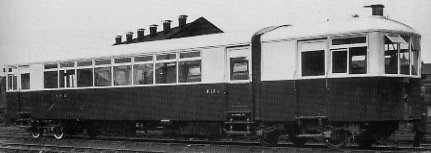
With the development of the superior Diagram 88 and Diagram 89 railcars (see below), the LNER investigated the possibility of rebuilding the original lightweight Diagram 14600-614E railcars with larger boilers, vertical engines, and improved riding characteristics. Sentinel offered two schemes. One scheme was to rebuild the cars so that they resembled the later cars as closely as possible. The LNER chose to rebuild railcar No. 12E to this scheme, and was described as Diagram 153. The second scheme was to rebuild the railcars to the minimum necessary to meet the requirements. No. 13E was rebuilt to this scheme, and was described by Diagram 152.
No. 13E returned to the LNER on 22nd May 1930 and was sent to Colwick for trials. By the time of its arrival at Doncaster two months later, it was apparent that the continued lack of buffers and drawgear were a serious problem. The lack of buffers meant that No. 13E was easily damaged when moving stock in sheds. Also, No. 13E could not be towed and had to be steamed if it was to be moved anywhere. Another problem was that the fireman now had to stoop to get coal, but then step up to put coal in the top of the firebox. Doncaster solved this latter problem by fitting a removable wooden floor. The floor only had to be removed to gain access to the sanders for refilling.
No. 13E was renumbered as No. 43307 in April 1932 and withdrawn in January 1940 with a mileage of 269,345 miles.
Diagram 153
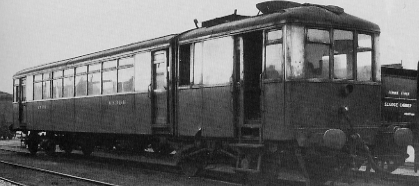
When rebuilding the original lightweight (Diagram 14600-614E) railcars, the LNER chose to have No. 13E subjected to an almost complete rebuild. This retained the original passenger body but conformed to the later Diagram 88 & 89 railcars as closely as practical. No. 12E was returned by Metro-Cammell on 29th May 1930 and started trials at Colwick. After repainting at Doncaster in late June, it entered traffic on 26th September 1930. The rebuild fitted a vertical engine and a 275psi boiler. New up-to-date bogies were also fitted. The passenger body appears to have been unchanged although it was raised 10.25in above rail height. This required the addition of a third step below the door ways. Unlike Diagram 152, drawgear and buffers were fitted.
The engine compartment was extended in length by 18 inches. This allowed the fitting of a proper coal bunker, roof trap doors for coaling, a larger boiler, and the vertical engine.
No. 12E was renumbered as No. 43306 in November 1931, and was withdrawn in April 1940 with a mileage of 232,462 miles.
Diagram 88

With increasing road competition, it was proposed to purchase two improved Sentinel railcars. Wedgwood financed these on the 1927 Build Programme by reducing the number of N7 0-6-2Ts and bogie third class coaches. The two railcars were completed in March 1927 and were described by Diagram 88. No. 21 entered service at Hull Botanic Gardens, and No. 22 entered service at Heaton.
The changes were substantial and resulted in an increase in weight from 17 tons to 23.25 tones. A vertical engine was used instead of a horizontal one, but the 6.75in diameter cylinders and 9in stroke were retained. The vertical arrangement allowed for a better poppet valve layout. Both axles on the power bogie were driven directly from the engine with single chains.
The body was widened from 8ft to 9ft. This allowed the righthand seats to be increased from two to three. This resulted in the aisle being offset to the left and the seating capacity increasing to 64. As before, the saloon was divided into two parts and the luggage compartment was ftted with tip-up seats.
With a body pitched at conventional height, drawgear and buffers could be provided. Vacuum brake hoses were also fitted.
Diagram 89
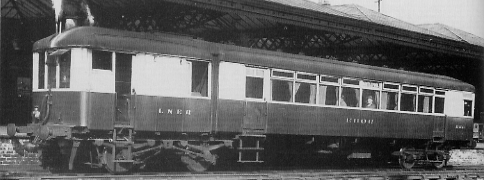
The LNER's steam railcar programme expanded greatly in the 1928 Build Programme, with an order for forty Sentinel steam railcars and ten Clayton steam railcars. The first twenty Sentinel railcars were delivered in the first half of 1928 to Diagram 89. The second twenty were deferred pending trials of a gear-driven railcar (Diagram 90 - see below). This was a success, and the final twenty were replaced with orders for gear-driven railcars (see below).
The Diagram 89 railcars were very similar to the earlier Diagram 88 railcars, but included a number of improvements. Trap doors in the engine compartment were modified so that the coal bunker could be filled using a conventional coal chute. The luggage compartment was moved forward so that it was directly behind the engine compartment. The exact reason for this unclear, but it may have been in an effort to reduce noise levels in the passenger saloon. The luggage compartment's tip-up seats were removed, and the entrance vestibule was enlarged - reducing the seating capacity to 59. The larger vestibule allowed more standing space and straps were provided for ten standing passengers.
Diagram 90
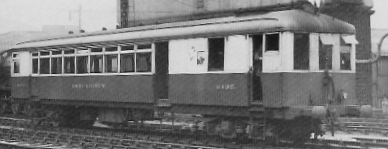
Sentinel decided to produce a railcar with a rigid body that removed the articulation between the passenger body and the power unit on the chain-driven railcars. The rigid body was mounted on two bogies and replaced the chain drive with a gear drive. An experimental gear-driven railcar was announced on 11th October 1927. If successful, it would be the first of an order for twenty gear-driven railcars that would replace the remaining railcars from an existing order for the chain-driven Diagram 89 railcars.
The experimental railcar was delivered on 19th December 1927 as No. 2135 (later named Integrity). Trials were satisfactory, and it officially entered LNER stock on 29th June 1928 as Diagram 90. A six cylinder engine was under development, and the remaining nineteen railcars of the order were delivered using this (see Diagrams 93 & 96 below). Integrity would remain the only two cylinder gear-driven Sentinel railcar constructed.
The power bogie was a conventional carriage bogie but carried the gearbox with a direct drive to the rear axle. The engine was mounted on top of the gearbox. The cylinders were enlarged slightly to 7in diameter, but the 9in stroke was retained. A slightly larger boiler was fitted with a small increase in firebox heating surface. The boiler pressure was raised to 300psi.
The one-piece body was 7in longer than the Diagram 89 body, but the internal seating plan remained the same.
Although it was built to a unique design, No. 2135 Integrity survived until November 1947, when it was one of the last Sentinel railcars to be withdrawn.
Diagram 93
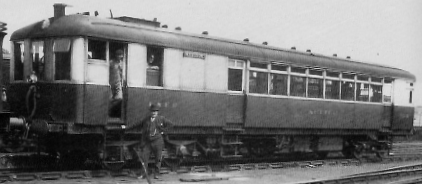
Whilst the first gear-driven railcar was being built (Diagram 90), Sentinel started to build their own experimental railcar with a rigid body. This railcar used a new six-cylinder engine horizontally positioned under the coach floor behind the power bogie. This engine had a transverse orientation, and drove the front axle of the lead bogie via a cardan shaft and gearbox. The new railcar became LNER No. 2133 Nettle and was described by Diagram 93. It was based at Starbeck for trials in May 1928, but also ran demonstration runs on the steep Whitby routes. With main line speeds of 40mph being easily attained with low noise levels and no vibrations, the order for the remaining eighteen railcars was approved (see Diagram 96).
The six cylinders had a 6in bore and a 7in stroke. These were only single acting, unlike the earlier double acting two cylinder engines. The increase in the number of cylinders resulted a much smoother torque and hence reduced vibration. The use of a gear drive also helped to reduce noise levels. The cardan shaft could be easily disconnected, allowing the Sentinel railcar to be towed in the event of a seized engine. The bogies were fitted with Skefko roller bearing axleboxes.
Only one water tank was fitted but this could hold 315 gallons. Other than the engine position, the body of Nettle was virtually the same as that of Integrity. The passenger saloon layout was identical, but the luggage compartment was extended 3ft 3in. The extra space was taken from the engine compartment which no longer had to house the actual engine.
Diagram 96
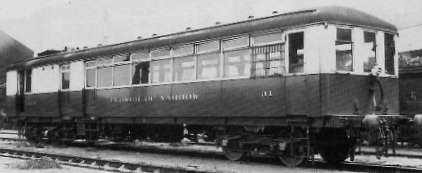
With the success of Diagram 93 Nettle, the remaining eighteen railcars of the outstanding order were built. These were built to virtually the same design but used conventional axleboxes and had a different internal body arrangement. The new Diagram 96 railcars were delivered in 1928-9.
The doors were moved to the front of the passenger saloon from the back. This avoided passengers using the connected luggage compartment to gain access to/from the passenger saloon. The seating capacity remained at 59, although the exact arrangement of fixed and reversible seats changed slightly.
Diagram 97 and the Cheshire Lines Committee Railcars
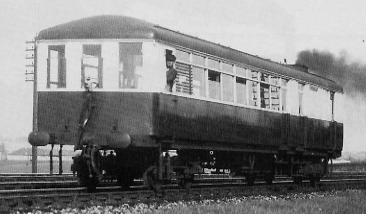
Thirty four more Sentinel railcars were announced in April 1928 as a part of the 1929 Build Programme. Orders for twenty eight Diagram 97 railcars were placed on 22nd February 1929. The remaining six railcars were to double-engined designs (see below). At the same time, the Cheshire Lines Committee (CLC) ordered four railcars to same Diagram 97 design, and these were operated by the LNER who part-owned the Cheshire Lines.
The Diagram 97 railcars were mechanically identical to the previous six-cylinder gear-driven Diagram 96 railcars. The LNER Diagram 97 railcars substituted alternate windows from a fixed to a drop light pattern, and the double-acting opening toplights were made fixed. These toplights tended to become detached and lost on earlier railcars. The sliding window behind the doors on either side of the engine compartment were replaced with sliding shutters. This was probably because this location would have been prone to damage.
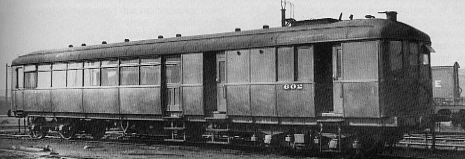
The engine compartment shutters were the only one of these changes fitted to the CLC cars. Strangely, they were still described as Diagram 97.
Diagram 209 (ex-Axholme Joint Railway)
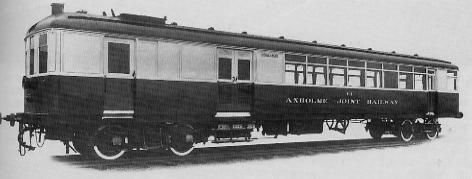
The Axholme Joint Railway (AJR) opened in 1903 and was jointly owned by the Lancashire & Yorkshire and North Eastern railways. It connected Marshland Junction near Goole (NER) to Haxey Junction (GN&GE Joint Railway) between Doncaster and Gainsborough. After Grouping (1923), motive power was supplied by the LMS. A modern Sentinel steam railcar was ordered for the AJR in February, to replace a lightweight Sentinel railcar similar to LNER Diagram 14600-614E. The new railcar was given the number '44' and painted in green & cream. Passenger services ceased on the AJR in 1933, and No. 44 entered LNER stock in November 1933 as No. 51915 and described by Diagram 209. It was immediately reconditioned at Gorton and returned to traffic in January 1934.
No. 51915 was similar to the LNER's existing six-cylinder gear-driven railcars except it was 3ft longer. The larger passenger saloon could seat 64 people, and tip-up seats in the luggage compartment could seat an additional ten people.
Diagram 98
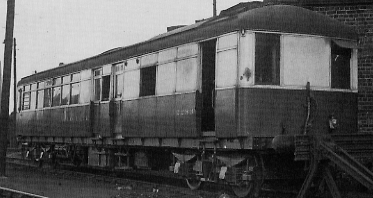
The final three designs of steam railcar that Sentinel delivered to the LNER, were of a double-engine design. The first design was Diagram 98. Two were ordered in February 1929, and they were delivered in 1930. Numbered 2281 & 2283, parts for one of these were actually transferred from a cancelled LMS order.
As with the existing six-cylinder gear-driven railcars, a horizontal engine was placed behind the front power bogie and drove the front axle of the bogie. However, a second engine was placed at the rear, in-front of the rear power bogie. The crankshafts and cardan shafts of both engines were in line with the centre of the car, but the engines were both offset. The front engine was offset to the left, and the rear engine was offset to the right. In order to provide sufficient steam for both engines, the conventional Sentinel boiler was replaced with a larger Woolnough marine-type water tube boiler. No. 2281's boiler was rated at 250psi, and No. 2283's boiler was rated 300psi. A nominal horsepower of 200hp was recorded for both railcars.
Externally, the Diagram 98 railcars resembled the earlier Diagram 97 railcars. However the new boiler required the engine compartment's roof to be raised, and its length to be increased by 6ft. The coal bunker was also moved to the very front of the engine compartment, because the new boiler had to be fired from the front. The re-positioning of the coal bunker, also resulted in the roof trap doors being moved noticeably forward.
Diagram 99 & 100 Twin-coach Articulated Railcar
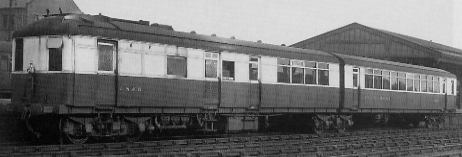
In addition to the Diagram 98 railcars, the LNER ordered a double-engined railcar with an articulated trailer. The rear power bogie was shared between the Sentinel railcar and the trailer. The railcar was described by Diagram 100 and numbered 2291, whilst the articulated trailer was described by Diagram 99 and numbered 2294. The name of Phenomena was carried on the trailer. The twin car unit was delivered to York on 29th September 1930. Early trials on the route to Scarborough reached a top speed of 64mph.
The power car was based on Diagram 98 No. 2283 with its 300psi boiler. The railcar body was shortened by 9ft 6in, allowing the rear power bogie to be shared with the trailer. In contrast, the trailer body was 1ft longer than than the railcar body. A gangway connection connected the two vehicles. The total seating capacity was 112: 39 in the power car, and 83 in the trailer. The power car retained the luggage compartment but this was extended by 2ft 3in. The trailer car consisted of one long passenger saloon with no divisions. A standard driver's compartment was fitted at the rear.
Diagram 159
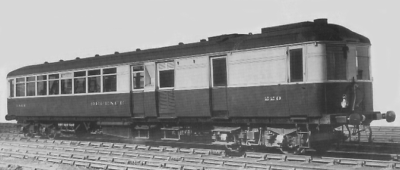
The LNER ordered its last Sentinel railcars in January 1932. The order consisted of three Diagram 159 railcars, and all were delivered in November/December 1932. As the LNER's final order, these three railcars represented the ultimate development of the Sentinel/LNER steam railcars.
Diagram 159 retained the double-engined six cylinder design of Diagram 98, but the coach body was extended by 3ft 6in to 65ft. The bogie wheelbases were also extended from 7ft to 7ft 6in. The boiler compartment remained the same size, but the luggage compartment was shortened by 6in. These length changes allowed the passenger saloon to include an extra row of seats. Larger semi-bucket seats were used, which resulted in a reduction from five seats per row to four seats per row. The total seating capacity was 48.
A 300psi Woolnough Type 4 boiler was fitted. This time it was turned around, allowing it to be fueled from the rear. Feed water was pre-heated using a vertical feed drum around the chimney. Valve modifications allowed 300hp to be available, although the railcars continued to be rated at 200hp.
As the last Sentinel railcars to enter service with the LNER, the Diagram 159 cars had relatively short lives. No. 248 Tantivy was withdrawn in September 1939 with a mileage of 146,140 miles. No. 220 Defence and No. 246 Royal Sovereign were withdrawn in September 1940 and August 1941 respectively.
Railcar Operations
The first two railcars, Nos. 12E & 13E were allocated to Norwich and Cambridge respectively. No. 13E is known to have run trials on local branches before joining No. 12E at Norwich in September 1925. Both operated local services to Lowestoft until they 1930 when they were replaced by Clayton steam railcars. They were then modified by Metro-Cammell before returning to work at Annesley. Both were withdrawn in 1940.
The Southern Area had a total of nine Sentinel railcars including Nos. 12E & 13E. The other seven were frequently transferred between the sheds of: King's Cross, Hitchin, Colwick, Annesley, Copley Hill, Chester, Wigan, and Gorton. The King's Cross railcars were usually used on the Edgware Branch. Hitchin usually had one railcar to operate services to Hertford North. The Colwick railcar was usually used on local services from Nottingham Victoria to Sutton-in-Ashfield, Chesterfield Market Place, Shirebrook South, and Ilkeston. Sentinel railcars were used at Annesley for the final ten years of the 'Dido' staff shuttle. Annesley railcars were also used for local services to Hucknall. Copley Hill used its Sentinel railcar for services between Leeds Central, Castleford, and Wakefield. Chester used a railcar to operate a weekday service between Northgate station and Shotton. During the 1930s, Wigan used a railcar to operate a service between Wigan, Glazebrook, and Lowton St. Mary's. The Sentinel railcars had problems with poor water at Wigan and the railcar was replaced by a conventional steam locomotive in April 1940. Finally, Gorton used the Sentinel railcar Commerce to replace the ex-GCR Petrol-Electric Railcar ('The Bollington Bug') on the Macclesfield to Bollington service in August 1935. Commerce returned to Colwick in January 1939 when the Bollington service was suspended.
The Cheshire Lines were jointly owned by the LMS and the LNER. The Cheshire Lines Committee (CLC) purchased four Sentinel railcars (Nos. 600-3) in July 1929. All four railcars were operated by he LNER, although none were named. The intention was for their to be three operating diagrams and a spare railcar, but in reality the Sentinel railcars operated four diagrams each week. These diagrams included local services from Liverpool and Stockport, as well as operations on the Cuddington-Winsford branch. Two of these workings reached beyond the Cheshire Lines to Marple and Widnes. The workings were modified a few times, but were significantly cut back with the outbreak of World War 2. By November 1941, three of the CLC railcars were in storage. The final CLC railcar, No. 602 entered storage in July 1944 and was withdrawn on 16th October 1944.
The North East area saw much greater use of the Sentinel railcars. This was partly because the North Eastern Railway (NER) had started to withdraw the aging G6 0-4-4T ('BTP') push-pull tank engines in 1921, and the LNER found it needed a suitable replacement. During the period 1922 to 1925, the NE Area also saw a 36% decrease in short distance bookings due to increasing road competition. It was felt that this traffic could only be regained with the use of more frequent services hauled by economic steam railcars. Early trials in 1926-7 included the Ponteland branch from Newcastle, the York-Whitby-Scarborough-York loop, and Hull to Beverley & Brough. These were followed by the widespread introduction of railcars with the delivery of twenty in the first half of 1928. Early in their careers, the introduction of a railcar on a new service was usually announced with handbills. By September 1928, Sentinel railcars were working Hull to Hornsea, Withernsea, South Howden, Brough, Beverley; Selby to Goole, York, Cawood, Staddlethorpe; Bishop Auckland to Wolsingham, Ferryhill, Durham, Sunderland; Darlington to Tow Law; Harrogate to Knaresborough; South Shields to Sunderland; West Hartlepool to Hartlepool; Cudworth to Kirk Smeaton & Wath; Leeds to Wetherby, Harrogate, Ilkley; Malton to Gilling; Pickering to Scarborough; and Newcastle to Blackhill, Sunderland, Leamside, North Wylam, Prudhoe, Ponteland, Darras Hall, Morpeth, Newbiggin. Nine further Sentinel railcars were delivered to the NE Area at the end of 1928. These were followed by eighteen more between August and November 1929. The NE Area allocation peaked at 56 at the end of 1932.
The NE Area made good use of the Sentinel railcars early on in their lives. A survey in 1932 found that many of the railcars were working for 16-17 hours a day and that they were being operated by two or three crews. The Sentinels were usually used on the lighter loads during the day and in the evening, leaving the busier periods to conventional locomotive-hauled trains.
NE Area withdrawals started in September 1939. The earliest railcars tended to be withdrawn first. As branch line services were reduced during wartime, many of the redundant Sentinel railcars were transferred to Darlington for storage instead of being withdrawn. These stored railcars were used for replacements as expired railcars were withdrawn. By 1947, the NE Area had only two railcar duties remaining in operation. One railcar at Starbeck hauled services between Harrogate and Knaresborough, whilst the other at Selby worked services to Goole. The Carriage Roster of 6th October 1947 replaced these two duties with push-pull units. The last NER Sentinel steam railcar Hope was withdrawn on 14th February 1948. This was also the last LNER Sentinel railcars in service.
The Scottish Area borrowed No. 21 Valliant from the NE Area for trials between 24th March and 12th July 1928. These trials were based from St. Margaret's shed and included the Leith Central branch, the North Leith branch, and a run to North Berwick. This latter run was loaded and resulted in a loss of drive chain whilst running at speed. Records of other trials are sketchy, but No. 21 was also recorded at St Kipps in May 1928. After the drive chain incident, James Calder (Scottish Area General Manager) insisted on the newer gear-driven Sentinel railcars. The first transfer was the nearly-new Nettle on 30th June 1928. This was followed by a number of new gear-driven railcars, and the Scottish Area had an allocation of fifteen Sentinel railcars by 1931. This dropped to fourteen when North Briton returned to the NE Area in 1933. The Scottish Sentinels were allocated to Carlisle, St. Margaret's, Haymarket, Eastfield, Kipps, Stirling, Thornton, and Dunfermline. As with the other areas, the railcars were typically used on light branch line work. They were particularly unpopular on the North Leith line, where they were also required to carry fish. This had to be loaded into the luggage compartment with the result that the smell permeated the entire railcar. A fish van was attached if the fish load was too large for the luggage compartment, but this would put a heavy load on the boiler when ascending gradients.
The Great North of Scotland section trialled a Sentinel steam railcar in February 1929. This was followed by a single allocation of Highland Chieftain from Stirling to Kittybrewster in September 1929. This was regularly used for services between Banchory, Dyce, and Ellon. It returned to Stirling after one year, and the GNS section received no further visits from the Sentinel railcars.
The Sentinel steam railcars were popular with enthusiasts who called them 'Chip Vans' due to their bright colours and smoking chimney. The general public were also interested in them due to their colours, and they were exhibited at a number of rolling stock exhibitions across the LNER network. However, the Sentinel railcars were never very popular with the enginemen, and especially the firemen. They were known as 'sweat boxes', and could be very temperamental in their running. Even at their best, their performance could be considered disappointing even with the use of special coal (eg. Bo'ness coal reserved for the Sentinels in the Scottish Area).
Technical Details
The Sentinel railcars were under almost continual development. This makes their technical details difficult to summarise, so the details are split into three tables covering the development overview, dimensions, and boilers.
The first table is an overview of the main Sentinel railcar development (H=Horizontal, V=Vertical, D=Double):
| Year: | 1925 | 1927-8 | 1928 | 1928-31 | 1930-2 | 1930 |
| Engine Layout: | Horizontal | Vertical | Vertical | Horizontal | Double | Double |
| No. Cylinders: | 2 | 2 | 2 | 6 | 12 | 12 |
| Nominal Power: | 100hp | 100hp | 100hp | 200hp | 200hp | |
| Drive: | Chain | Chain | Gear | Gear & Shaft | Gear & Shaft | Gear & Shaft |
| Boiler: | Vertical | Vertical | Vertical | Vertical | Marine | Marine |
| Body: | Lwt Articulated | Articulated | Rigid | Rigid | Rigid | Twin car |
| Carriage Diagram: | 14600-614E | 88, 89 | 90 | 93, 96, 97 | 98, 159 | 99, 100 |
| No. Built: | 2 | 22 | 1 | 49 | 5 | 1 |
Note that Diagram Nos. 14600-614E (railcar nos. 12E & 13E) were rebuilt in 1930. The dimensions after building matched those of Diagram 88 & 89 except they retained their 8ft width and their 52 seat seating capacity.
Diagram 100 referred to the power car in the twin unit, and Diagram 99 referred to the trailer. The trailer had 3ft 1in diameter wheels on a 6ft 6in bogie wheelbase. Its 52ft long, 9ft wide body had seats for 83 people.
Seating counts do not include flip-down seats provided in the luggage compartment.
The next table describes the main body dimensions:
| Year: | 1925 | 1927 | 1928 | 1928 | 1930 | 1930 | 1930 twin | 1932 |
| Carriage Diagram: | 14600-614E | 88, 89 | 90 | 93, 96, 97 | 209 | 98 | 100 (power) | 159 |
| Cylinders: | 6.75x9in | 6.75x9in | 7x9in | 6x7in | 6x7in | 6x7in | 6x7in | 6x7in |
| Power: | 275hp | 300hp | 300hp | 300hp | 300hp | 300hp | 300hp | 300hp |
| Bogie Wheels: | 2ft 6in | 3ft 1in | 3ft 1in | 3ft 1in | 3ft 1in | 3ft 1in | 3ft 1in | 3ft 1in |
| Front Wheelbase: | 7ft | 8ft 6in | 7ft | 7ft | 7ft | 7ft | 7ft | 7ft 6in |
| Rear Wheelbase: | 5ft 6in | 6ft 6in | 6ft 6in | 6ft 6in | 6ft 6in | 7ft | 7ft | 7ft 6in |
| Total Wheelbase: | 45ft 7in | 47ft 7in | 47ft 4in | 47ft 4in | 50ft 4in | 52ft 6in | 97ft 6in | 64ft 6in |
| Length (body): | 56ft 5in | 57ft 11in | 58ft 6in | 58ft 6in | 61ft 6in | 61ft 6in | 51ft | 65ft |
| Width: | 8ft | 9ft | 9ft | 9ft | 9ft | 9ft | 9ft | 9ft |
| Seats: | 52 | 59 | 59 | 59 | 64 | 54 | 39 | 48 |
| Weight (empty): | 17t 0cwt | 23t 6.5cwt | 28t 15cwt | 28t 15cwt | 29t 5cwt | 42t 12cwt | 52t 17cwt | 41t 7cwt |
The following table details the boiler variants. Note that some of the boiler details were not recorded by the LNER. Superheater heating surfaces are poorly recorded, and the LNER did not record details of the Woolnough boilers on the double-engine cars.
| Railcars: | Diagram 14600-614E | Remaining chain-driven | All gear driven | |||
| Introduced: | 1925 | 1927 | 1931 | 1928 | 1931 | |
| Boiler: | Diameter (top): | 2ft 8.5in | 3ft 1in | 3ft 1in | 3ft 1in | 3ft 1in |
| Pressure: | 275psi | 275-300psi | 275-300psi | 300psi | 300psi | |
| Heating Surface: | Total: | 64.15 sq.ft. | ? | ? | ? | ? |
| Superheater: | 9.7 sq.ft. | ? | ? | ? | ? | |
| Firebox: | 26.7 sq.ft. | 35 sq.ft. | 31 sq.ft. | 36.5 sq.ft. | 32.6 sq.ft. | |
| Tubes: | 27.73 sq.ft. (30x 1.75in) | 36.5 sq.ft. (30x 2in) | 33.25 sq.ft. (28x 2.75in) | 36.5 sq.ft. (30x 2in) | 35.6 sq.ft. (28x 2.75in) | |
| Grate Area: | 3.97 sq.ft. | 5.1 sq.ft. | 5.1 sq.ft. | 5.1 sq.ft. | 5.1 sq.ft. |
Preservation
The last Sentinel steam railcar was withdrawn in 1948, and none have survived into preservation.
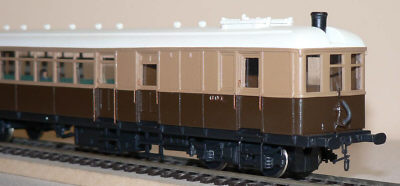
Models
Langley sell a whitemetal kit of the Sentinel steam railcar in N gauge.
Nu-Cast also sell a OO gauge (4mm scale) kit.
Railcar Names
With the exception of the AJR and Cheshire Lines railcars, all of the Sentinel steam railcars received names. A competition was held in the LNER Magazine for a suitable name. The prize was shared between the best suggestions of dogs and playing cards, although neither theme was actually used. Instead, it was decided to name the railcars after old stage coaches which were, quote "both romantic and short in title". Most of the railcars carried a notice detailing information about the stage coach and offering a reward for further information. Unfortunately the text of most of these notices has not been recorded. With a number of duplicate stage coaches, it is unclear exactly which stage coach many of railcars are named after.
Some railcars were renumbered, and these are listed with the date of the renumbering.
No. 51915 was built in December 1930 and initially worked on the Axholme Joint Railway as No. 44. The date of November 1933 in the table represents the date of purchase by the LNER.
| Diagram No. | Build Date | LNER No. | 2nd No. | Disposal Date | Name |
| 14600-614E | 5/25 | 12E | 43306 (11/31) | 4/40 | |
| 14600-614E | 5/25 | 13E | 43307 (4/32) | 1/40 | |
| 88 | 5/27 | 21 | 2/44 | Valliant | |
| 88 | 5/27 | 21 | 12/42 | Brilliant | |
| 89 | 1/28 | 26 | 8/45 | Tally-Ho | |
| 89 | 3/28 | 29 | 2/44 | Rockingham | |
| 89 | 2/28 | 210 | 11/45 | Highflyer | |
| 89 | 3/28 | 212 | 2/42 | Eclipse | |
| 89 | 3/28 | 220 | 6/29 | Waterwitch | |
| 89 | 3/28 | 225 | 12/42 | True Blue | |
| 89 | 3/28 | 226 | 9/39 | Ebor | |
| 89 | 3/28 | 237 | 12/44 | Rodney | |
| 89 | 3/28 | 238 | 8/45 | Yorkshire Huzzar | |
| 89 | 4/28 | 244 | 3/46 | True Briton | |
| 89 | 4/28 | 250 | 11/45 | Red Rover | |
| 89 | 4/28 | 253 | 3/46 | Rob Roy | |
| 89 | 4/28 | 254 | 6/46 | Phoenix | |
| 89 | 4/28 | 255 | 5/40 | Perseverance | |
| 89 | 5/28 | 263 | 3/46 | North Star | |
| 89 | 5/28 | 265 | 11/45 | Neptune | |
| 89 | 5/28 | 267 | 2/44 | Liberty | |
| 89 | 5/28 | 272 | 10/46 | Hero | |
| 89 | 5/28 | 273 | 3/46 | Trafalgar | |
| 89 | 6/28 | 283 | 12/44 | Teazle | |
| 90 | 6/28 | 2135 | 11/47 | Integrity | |
| 93 | 5/28 | 2133 | 35 (8/28) | 8/45 | Nettle |
| 96 | 11/28 | 31 | 9/43 | Flower of Yarrow | |
| 96 | 11/28 | 45 | 43301 (6/31) | 1/40 | Commerce |
| 96 | 12/28 | 2133 | 10/43 | Cleveland | |
| 96 | 12/28 | 2136 | 2/48 | Hope | |
| 96 | 12/28 | 2139 | 6/46 | Hark Forward | |
| 96 | 12/28 | 2140 | 10/44 | Eagle | |
| 96 | 12/28 | 2144 | 8/45 | Traveller | |
| 96 | 12/28 | 2145 | 2/43 | Ruby | |
| 96 | 12/28 | 2147 | 1/47 | Woodpecker | |
| 96 | 12/28 | 2151 | 5/46 | Umpire | |
| 96 | 12/28 | 2152 | 7/43 | Courrier | |
| 96 | 12/28 | 51908 | 8/43 | Expedition | |
| 96 | 1/29 | 51909 | 1/46 | Waterloo | |
| 96 | 1/29 | 32 | 2/44 | Fair Maid | |
| 96 | 1/29 | 33 | 1/45 | Highland Chieftain | |
| 96 | 1/29 | 34 | 12/45 | Tweedside | |
| 96 | 1/29 | 36 | 8/46 | Royal Eagle | |
| 96 | 1/29 | 37 | 2/45 | Clydesdale | |
| 97 | 10/29 | 2198 | 10/44 | Times | |
| 97 | 8/29 | 38 | 4/47 | Pearl | |
| 97 | 8/29 | 39 | 6/44 | Protector | |
| 97 | 8/29 | 51912 | 1/46 | Rising Sun | |
| 97 | 8/29 | 51913 | 1/46 | Rival | |
| 97 | 8/29 | 51914 | 8/43 | Royal Forester | |
| 97 | 8/29 | 2200 | 9/43 | Surprise | |
| 97 | 8/29 | 2217 | 10/46 | Royal Charlotte | |
| 97 | 8/29 | 2218 | 12/44 | Telegraph | |
| 97 | 9/29 | 2219 | 6/46 | New Fly | |
| 97 | 9/29 | 2231 | 7/47 | Swift | |
| 97 | 9/29 | 2232 | 6/44 | Alexander | |
| 97 | 9/29 | 2235 | 9/44 | Britannia | |
| 97 | 9/29 | 2236 | 12/44 | British Queen | |
| 97 | 9/29 | 2238 | 2/43 | Celerity | |
| 97 | 9/29 | 310 | 7/43 | Prince Regent | |
| 97 | 10/29 | 311 | 31073 (10/31) | 10/47 | Quicksilver |
| 97 | 10/29 | 312 | 5/46 | Retaliator | |
| 97 | 10/29 | 2242 | 6/46 | Cornwallis | |
| 97 | 10/29 | 2245 | 11/45 | Criterion | |
| 97 | 10/29 | 2257 | 8/45 | Defiance | |
| 97 | 10/29 | 2261 | 11/45 | Diligence | |
| 97 | 10/29 | 2267 | 11/47 | Recovery | |
| 97 | 10/29 | 2268 | 10/43 | Emerald | |
| 97 | 11/29 | 2270 | 4/46 | Independent | |
| 97 | 11/29 | 2271 | 10/46 | Industry | |
| 97 | 4/30 | 2276 | 3/46 | North Briton | |
| 97 | 4/30 | 2279 | 10/44 | Norfolk | |
| 98 | 6/30 | 2281 | 11/41 | Old John Bull | |
| 98 | 10/30 | 2283 | 9/41 | Old Blue | |
| 100 | 9/30 | 2291 | 5/42 | Phenomena | |
| 97 | 1/31 | 313 | 9/44 | Banks of Don | |
| 97 | 1/31 | 314 | 8/45 | Queen of Beauty | |
| 159 | 11/32 | 220 | 9/40 | Defence | |
| 159 | 12/32 | 246 | 8/41 | Royal Sovereign | |
| 159 | 12/32 | 248 | 9/39 | Tantivy | |
| 209 | 11/33 | 51915 | 7/44 |
Acknowledgements
Thank you to Morgan Gilbert for the above picture of his Nu-Cast model of Cheshire Lines railcar No. 601.
Thank you to Richard Nixon for corrections regarding Galloways firebox construction.